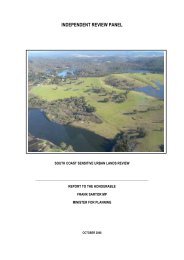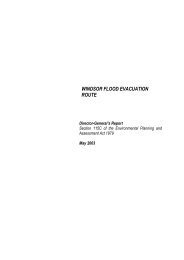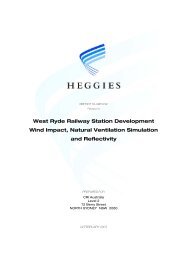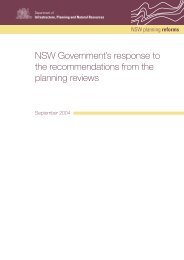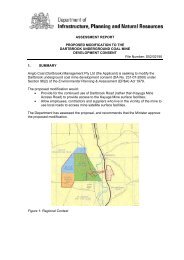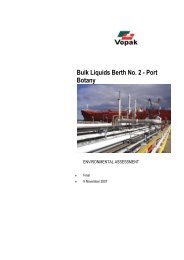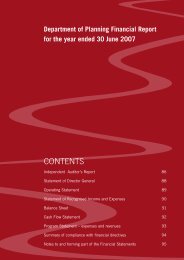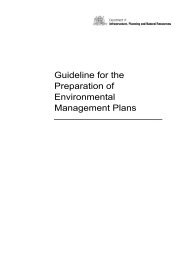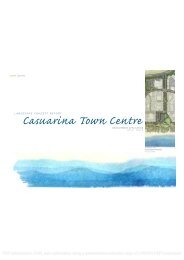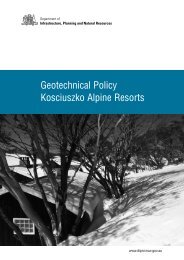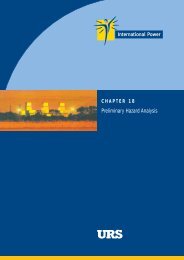Preliminary Environmental Assessment - Department of Planning
Preliminary Environmental Assessment - Department of Planning
Preliminary Environmental Assessment - Department of Planning
Create successful ePaper yourself
Turn your PDF publications into a flip-book with our unique Google optimized e-Paper software.
<strong>Preliminary</strong> <strong>Environmental</strong> <strong>Assessment</strong><br />
For<br />
Ben Lomond Wind Farm<br />
Prepared for<br />
Allco Wind Energy Management Pty Ltd<br />
Level 20 Gateway<br />
1 Macquarie Place<br />
Sydney NSW 2000<br />
Job Reference 24861 - January 2008
PRELIMINARY ASSESSMENT – BEN LOMOND WIND FARM<br />
PREPARED BY:<br />
RPS Harper Somers O’Sullivan Pty Ltd<br />
PO Box 428<br />
Hamilton NSW 2303<br />
Tel: (02) 4961 6500<br />
Fax: (02) 4961 6794<br />
Web: www.rpshso.com.au<br />
PROJECT: PRELIMINARY ENVIRONMENTAL ASSESSMENT – BEN LOMOND WIND FARM<br />
CLIENT:<br />
ALLCO WIND ENERGY MANAGEMENT PTY LTD<br />
OUR REF 24861<br />
DATE: JANUARY 2008<br />
APPROVED BY:<br />
STEVE MCCALL<br />
SIGNATURE:<br />
CHECKED BY:<br />
TOBY LAMBERT<br />
SIGNATURE:<br />
PREPARED BY RPS HARPER SOMERS O’SULLIVAN JANUARY 2008
PRELIMINARY ASSESSMENT – BEN LOMOND WIND FARM<br />
CONTENTS<br />
1 INTRODUCTION ..................................................................................................1<br />
2 THE PROPOSAL ..................................................................................................1<br />
2.1 Objectives <strong>of</strong> the proposal............................................................................1<br />
2.2 Description <strong>of</strong> the proposal...........................................................................1<br />
2.3 Indicative Site layout plans...........................................................................3<br />
3 SITE DESCRIPTION AND LOCALITY INFORMATION .......................................5<br />
4 STATUTORY CONTEXT AND PLANNING INSTRUMENTS ...............................5<br />
4.1 Introduction...................................................................................................5<br />
4.2 State <strong>Environmental</strong> <strong>Planning</strong> Policy (Major Projects) 2005 ........................6<br />
4.3 Threatened Species Conservation Act 1995 & Environment Protection and<br />
Biodiversity Conservation Act 1999..............................................................6<br />
4.4 Guyra Local <strong>Environmental</strong> Plan 1988.........................................................7<br />
4.5 Severn Local <strong>Environmental</strong> Plan 2002 .......................................................7<br />
4.6 State <strong>Environmental</strong> <strong>Planning</strong> Policy No. 44 – Koala Habitat Protection .....7<br />
5 THE ENVIRONMENTAL ISSUES.........................................................................7<br />
5.1 Landscape and visual issues .......................................................................7<br />
5.2 Shadow flicker ..............................................................................................8<br />
5.3 Noise issues .................................................................................................8<br />
5.4 Traffic and Access........................................................................................8<br />
5.5 Communication issues .................................................................................9<br />
5.6 Drainage issues............................................................................................9<br />
5.7 Flora and fauna issues .................................................................................9<br />
5.8 Heritage issues...........................................................................................10<br />
5.9 Socio-Economic issues ..............................................................................10<br />
5.10 Aviation issues ...........................................................................................10<br />
5.11 Bushfire Issues...........................................................................................11<br />
5.12 Safety issues ..............................................................................................11<br />
5.13 Cumulative issues ......................................................................................11<br />
6 COMPILATION OF MITIGATION MEASURES ..................................................11<br />
7 CONCLUSION ....................................................................................................12<br />
PREPARED BY RPS HARPER SOMERS O’SULLIVAN JANUARY 2008
PRELIMINARY ASSESSMENT – BEN LOMOND WIND FARM 1<br />
1 INTRODUCTION<br />
RPS Harper Somers O’Sullivan acts on behalf <strong>of</strong> Allco Wind Energy Management<br />
Pty Ltd (Allco Wind Energy) in preparing this <strong>Preliminary</strong> <strong>Environmental</strong> <strong>Assessment</strong><br />
for Part 3A project in reference to a wind farm proposal for Ben Lomond, NSW.<br />
Under State <strong>Environmental</strong> <strong>Planning</strong> Policy (Major Projects) 2005 development that,<br />
in the opinion <strong>of</strong> the Minister, is development <strong>of</strong> a kind that is described in Schedule 1<br />
is declared to be a project to which Part 3A <strong>of</strong> the <strong>Environmental</strong> <strong>Planning</strong> and<br />
<strong>Assessment</strong> Act 1979 (EP &A Act) applies.<br />
This report provides a description <strong>of</strong> the development proposal, lists relevant<br />
planning instruments and provides a general description <strong>of</strong> the key environmental<br />
issues that will be addressed as part <strong>of</strong> the <strong>Environmental</strong> <strong>Assessment</strong>.<br />
2 THE PROPOSAL<br />
2.1 Objectives <strong>of</strong> the proposal<br />
Wind power is now considered a mature and cost-effective technology to secure<br />
environmentally sustainable power generation for the future. The objective <strong>of</strong> the<br />
proposal is to generate emission free renewable energy to be distributed into the<br />
National Electricity Network close to existing electricity transmission lines.<br />
More than 80% <strong>of</strong> Australia’s energy currently comes from coal-fired power stations,<br />
with less than 10% coming from clean renewable sources. Energy demands in NSW<br />
are growing significantly, with demand in the Newcastle – Sydney – Wollongong area<br />
alone growing at around 300 megawatts (MW) per year. Increasingly, consumers<br />
are seeking electricity generated from renewable sources rather than fossil fuels that<br />
contribute to the greenhouse effect. This project will provide a new, clean, renewable<br />
source <strong>of</strong> energy for the State’s growing population – meeting the average annual<br />
electricity consumption needs <strong>of</strong> approximately 60,000 dwellings which is equivalent<br />
to satisfying the power requirements <strong>of</strong> a city more than twice the size <strong>of</strong> Armidale.<br />
Wind power does not require water for cooling and therefore significantly reduces the<br />
burden on the State’s water supply. The project will result in substantial savings in<br />
water consumption and reduced pollution by replacing coal and other fossil fuel-fired<br />
electricity.<br />
The new Australian Government has set a 20% Renewable Energy Target for<br />
Australia to reach by 2020. To achieve this, Federal Labor plans to increase the<br />
Mandatory Renewable Energy Target from 30,000 to 45,000 gigawatt hours (GWh)<br />
per year. The Ben Lomond Wind Farm will contribute to the Governments vision for<br />
the integration <strong>of</strong> renewable energy in the power generation mix.<br />
The Ben Lomond Wind Farm will also provide local participating landholders with<br />
additional income, which will add to the viability and sustainability <strong>of</strong> these traditional<br />
agricultural landholdings.<br />
2.2 Description <strong>of</strong> the proposal<br />
The proposed Ben Lomond Wind Farm will have an installed capacity <strong>of</strong> up to<br />
205MW. The project site is located north <strong>of</strong> the village <strong>of</strong> Ben Lomond in the New<br />
England Tablelands <strong>of</strong> northern NSW (see Figure 1). The site is adjacent to the New<br />
PREPARED BY RPS HARPER SOMERS O’SULLIVAN JANUARY 2008
PRELIMINARY ASSESSMENT – BEN LOMOND WIND FARM 2<br />
England Highway and is situated approximately halfway between the towns <strong>of</strong> Guyra<br />
and Glen Innes.<br />
Figure 1 - Site location map<br />
Approximate<br />
location <strong>of</strong><br />
subject site<br />
The proposal includes 98 wind turbine generators connected via underground cables<br />
to a substation located in the centre <strong>of</strong> the site, a facilities building and approximately<br />
8.5km <strong>of</strong> 132 kilovolt (kV) overhead power line that will connect the substation to the<br />
Transgrid 132kV Transmission Line that transects the site east <strong>of</strong> the New England<br />
Highway. Access roads to the turbines will be constructed so as to minimise impacts<br />
on the local environment during the construction <strong>of</strong> the project and to allow ongoing<br />
maintenance.<br />
Allco Wind Energy is currently considering two turbine options – Vestas V90/2.0MW<br />
and Suzlon S88-2.1MW or similar turbine models. Both turbines are suitable for the<br />
wind and terrain conditions observed at Ben Lomond. Alternative turbine models are<br />
under consideration which would have an equal or lower environmental impact.<br />
The Vestas V90-2.0 turbine has a nameplate generating capacity <strong>of</strong> 2,000 kW. The<br />
proposed tower height to the hub would be 80m above ground level (AGL), with the<br />
height to the blade tip reaching a maximum <strong>of</strong> 125m AGL. The rotor has 3 blades on<br />
the horizontal axis. The diameter <strong>of</strong> the rotor is 90m and covers a swept area <strong>of</strong><br />
6,361m². The Suzlon S88-2.1 turbine has a generating capacity <strong>of</strong> 2,100 kW. The<br />
proposed tower height to the hub would be 80m AGL, with the height to the blade tip<br />
reaching a maximum <strong>of</strong> 124m AGL. The rotor has 3 blades on the horizontal axis.<br />
The diameter <strong>of</strong> the rotor is 88m and covers a swept area <strong>of</strong> 6,082m².<br />
The ‘typical’ wind turbine, referred to above, should be regarded as indicative only for<br />
the purposes <strong>of</strong> the <strong>Preliminary</strong> <strong>Assessment</strong> with final turbine selection subject to<br />
availability and operation & maintenance guarantees. Final turbine design details will<br />
be determined prior to the preparation <strong>of</strong> the Construction Certificate. For the<br />
PREPARED BY RPS HARPER SOMERS O’SULLIVAN JANUARY 2008
PRELIMINARY ASSESSMENT – BEN LOMOND WIND FARM 3<br />
purpose <strong>of</strong> the assessment the analysis will be based on an indicative turbine layout<br />
consisting <strong>of</strong> 98 Vestas V90-2.0MW turbines.<br />
Both turbine models are suitable for the wind characteristics <strong>of</strong> the site and ensure<br />
that the rotor gathers the maximum power from the prevailing wind, while minimising<br />
loads and controlling output. The turbines will be connected through a 33kV<br />
underground cable network to a central substation within the wind farm area. The<br />
control cables will also link the turbines to a facilities building which will house an<br />
<strong>of</strong>fice, electrical and computer equipment, storage and amenities, as well as the main<br />
wind farm control room.<br />
The proposed substation will connect to the 132kV transmission line and national<br />
grid, which passes through the site, east <strong>of</strong> the New England Highway. Connection<br />
to the 132kV transmission line will require approximately 8.5km <strong>of</strong> overhead<br />
transmission line from the wind farm substation located on the property “Emily Park”<br />
to the proposed grid connection point (0377459E, 6680406N – UTM WGS84 56J)<br />
subject to reaching an agreement with Transgrid about the point <strong>of</strong> interconnect. The<br />
length <strong>of</strong> the overhead power line will depend on the final location <strong>of</strong> the substation<br />
within the site and the final location <strong>of</strong> the point <strong>of</strong> interconnect.<br />
The access tracks required for the construction and maintenance <strong>of</strong> the wind farm<br />
will be located on private land currently owned by project participants and typically<br />
are adjacent to the underground cable network and, where possible, utilise existing<br />
farm tracks. Tracks will be graded with road base gravel applied to the 10m wide<br />
track to facilitate the high construction loads. Upon completion <strong>of</strong> construction the<br />
access tracks will be returned to 4WD access tracks with a typical width <strong>of</strong> 4-4.5m.<br />
Each turbine footing will occupy a site <strong>of</strong> approximately 18m x 18m, however, the<br />
ground around each turbine will be rehabilitated following construction to allow<br />
agricultural activities to occur up to the base <strong>of</strong> the turbine tower, leaving an above<br />
ground footprint <strong>of</strong> approximately 16m².<br />
2.3 Indicative Site layout plans<br />
Figure 2-1 is a site plan illustrating an indicative layout <strong>of</strong> the wind farm turbines,<br />
cabling, substation, plus the location <strong>of</strong> the adjacent 132kV Transgrid power<br />
transmission easement and an aerial photograph <strong>of</strong> the site. The site layout will be<br />
finalised after the completion <strong>of</strong> the environmental assessments, identification <strong>of</strong> any<br />
site constraints and an analysis <strong>of</strong> the optimal layout that considers any site<br />
constraints and wind characteristics.<br />
PREPARED BY RPS HARPER SOMERS O’SULLIVAN JANUARY 2008
WARNING<br />
LEGEND<br />
No part <strong>of</strong> this plan should be used<br />
for critical design dimensions.<br />
Confirmation <strong>of</strong> critical Wind positions Farm<br />
should be obtained from RPS Harper Somers<br />
O'Sullivan Pty Ltd.<br />
Site Boundary<br />
To Glen Innes<br />
Internal Property<br />
Boundary<br />
Proposed Turbine<br />
Proposed Track<br />
132kv power<br />
transmission<br />
easement<br />
New England<br />
Highway<br />
Smithston<br />
Munsies<br />
Glencoe<br />
Village <strong>of</strong><br />
Glencoe<br />
SUBJECT<br />
SITE<br />
Crosby<br />
HIGHWAY<br />
Yolanda<br />
ENGLAND<br />
NEW<br />
Beulah<br />
Silent Grove<br />
Banoole<br />
Moorehead<br />
Kanes<br />
Emily Park<br />
Banoole<br />
Mt Emby<br />
Highfields<br />
TITLE:<br />
FIGURE 2 - 1<br />
INDICATIVE SITE LAYOUT<br />
Kenlossie<br />
To Village <strong>of</strong> Ben Lomond<br />
1km south<br />
CLIENT:<br />
Allco Wind Energy<br />
PLANNING SURVEYING ECOLOGY<br />
HARPER<br />
SOMERS<br />
O'SULLIVAN<br />
SCALE:<br />
Tarloon<br />
To Guyra<br />
1: 56000 at A3 Size<br />
Copyright<br />
"This document & the information shown shall remain the property <strong>of</strong> Harper<br />
Somers O'Sullivan Pty Ltd. The document may only be used for the purpose for<br />
which it was supplied and in accordance with the terms <strong>of</strong> engagement for the<br />
commission. Unauthorised use <strong>of</strong> this document in any way is prohibited."<br />
241 DENISON STREET BROADMEADOW PO BOX 428 HAMILTON NSW 2303<br />
0<br />
DRAWN:<br />
DATUM:<br />
LAYOUT REF:<br />
1.5 3<br />
kilometres<br />
L. Steel<br />
AMG Zone 56 (AGD 66)<br />
CONTOUR INTERVAL:<br />
T: 02 4961 6500 F: 02 4961 6794 E: survey@hso.com.au W:www.hso.com.au ABN 11 093 343 858<br />
APPROVED:<br />
DATE: 17/1/2008<br />
N/A<br />
JOB REF:<br />
24861<br />
S. McCall<br />
J:\24k\24861\Drafting\MapInfo\<strong>Planning</strong>\Prelim EA
PRELIMINARY ASSESSMENT – BEN LOMOND WIND FARM 5<br />
3 SITE DESCRIPTION AND LOCALITY<br />
INFORMATION<br />
The following points outline a description <strong>of</strong> the site and surrounding area:<br />
• Locality – Ben Lomond / Glencoe, New England Tablelands.<br />
• LGA – The Ben Lomond Wind Farm is to be located predominantly within the<br />
Guyra Shire. Part <strong>of</strong> the Wind Farm will also be located within surrounding<br />
districts <strong>of</strong> Glen Innes Severn Shire and borders the boundary <strong>of</strong> Inverell Shire.<br />
• Study Area – 9,990 ha (13 privately owned rural landholdings)<br />
• Zoning – Rural 1(a)<br />
• Current Land Use – Cattle and sheep grazing, agricultural production, rural<br />
dwellings.<br />
• Topography – The site lies on the Great Dividing Range (New England Range)<br />
with height ranges <strong>of</strong> 1,160 – 1,450 metres AHD.<br />
• Geology – Geology consists <strong>of</strong> tertiary basalts on the plateau centred on Guyra<br />
and Ben Lomond.<br />
• Soils – Chocolate soils and krasnozems on ridges and weisenbodens in valleys.<br />
• Vegetation – Mainly cleared, although remnant patches <strong>of</strong> tall open forests and<br />
open forests composed <strong>of</strong> Ribbon Gum, Snow Gum, Black Sallee, and Mountain<br />
Gum on basalt plateaux.<br />
• Hydrology – The site sits atop the Great Dividing Range with most <strong>of</strong> the site<br />
draining west into MacIntyre and Severn Rivers (eventually ending up in the<br />
Darling River). The eastern portions near Glencoe drain east into the Mann River<br />
(eventually ending up in the Clarence River). First and second order streams,<br />
including Grahams Valley Creek and Clerks Creek Hydrology, dominate the<br />
hydrology. Numerous farm dams occur throughout.<br />
4 STATUTORY CONTEXT AND PLANNING<br />
INSTRUMENTS<br />
4.1 Introduction<br />
The site is located across the boundaries <strong>of</strong> the Guyra and Glen Innes Severn Local<br />
Government Areas. The proposed wind farm requires development consent under<br />
Part 3A <strong>of</strong> the <strong>Environmental</strong> <strong>Planning</strong> and <strong>Assessment</strong> Act 1979 (EP&A Act). Under<br />
State <strong>Environmental</strong> <strong>Planning</strong> Policy (Major Projects) 2005 development that, in the<br />
opinion <strong>of</strong> the Minister, is development <strong>of</strong> a kind that is described in Schedule 1 is<br />
declared to be a project to which Part 3A <strong>of</strong> the Act applies. On the 2 nd January 2008<br />
the Director-General <strong>of</strong> the <strong>Department</strong> <strong>of</strong> <strong>Planning</strong>, as delegate <strong>of</strong> the Minister for<br />
<strong>Planning</strong>, formed the opinion that the proposed wind farm is a Major Project to which<br />
Part 3A <strong>of</strong> the Act applies.<br />
PREPARED BY RPS HARPER SOMERS O’SULLIVAN JANUARY 2008
PRELIMINARY ASSESSMENT – BEN LOMOND WIND FARM 6<br />
4.2 State <strong>Environmental</strong> <strong>Planning</strong> Policy (Major Projects)<br />
2005<br />
The project capital value is approximately $300,000,000. The capital value by virtue<br />
meets the criteria listed in Schedule 1 Part 3A projects-classes <strong>of</strong> development,<br />
Group 8 Transport, Communications, Energy and Water Infrastructure. Clause 24 –<br />
Generation <strong>of</strong> electricity <strong>of</strong> heat or co-generation, incorporates development for the<br />
purpose <strong>of</strong> a facility for the generation <strong>of</strong> electricity that has a capital investment<br />
value <strong>of</strong> more than $30 million. The Minister for the <strong>Department</strong> <strong>of</strong> <strong>Planning</strong> is the<br />
approval authority.<br />
4.3 Threatened Species Conservation Act 1995 &<br />
Environment Protection and Biodiversity Conservation<br />
Act 1999<br />
Pursuant to the EP&A Act 1979, developments requiring approval from a Council or a<br />
NSW statutory authority are required to be assessed in accordance with the<br />
Threatened Species Conservation Act 1995 (TSC Act). The Flora and Fauna<br />
<strong>Assessment</strong> to be undertaken will investigate and assess the potential impacts <strong>of</strong> the<br />
proposal and address the requirements under the TSC Act and Commonwealth<br />
Environment Protection and Biodiversity Conservation Act 1999 (EPBC Act).<br />
Previous studies have identified a list <strong>of</strong> those threatened flora / fauna / fish species,<br />
endangered populations and endangered ecological communities that have the<br />
potential to be found on site or within the region (as listed under the TSC Act and the<br />
EPBC Act.<br />
Previous Flora and Fauna investigations for parts <strong>of</strong> the site have confirmed that five<br />
(5) threatened flora species have been previously recorded within 10km <strong>of</strong> the site,<br />
these being Dichanthium setosum (Bluegrass), Eucalyptus camphora ssp. relicta<br />
(Warra Broad-leaved Sally), Eucalyptus mckieana (McKie’s Stringybark), Eucalyptus<br />
nicholii (Narrow-leaved Black Peppermint), and Thesium australe (Austral Toadflax).<br />
Three (3) threatened fauna species have been recorded on the site or in the<br />
immediate vicinity, namely Neophema pulchella (Turquoise Parrot), Saccolaimus<br />
flaviventris (Yellow-bellied Sheathtail Bat) and Miniopterus schreibersii (Eastern<br />
Bent-wing Bat). Three (3) other threatened fauna species has been recorded within<br />
10km <strong>of</strong> the site, these being Litoria castanea (Yellow-spotted Tree Frog),<br />
Phascolarctos cinereus (Koala) and Petrogale penicillata (Brush-tailed Rock<br />
Wallaby).<br />
The majority <strong>of</strong> vegetation within the study area consists <strong>of</strong> the preliminarily listed<br />
endangered ecological community - “Ribbon Gum - Mountain Gum - Snow Gum<br />
Grassy Forest/Woodland <strong>of</strong> the New England Tableland Bioregion”.<br />
Given that a number <strong>of</strong> the factors regarding the ecological impacts <strong>of</strong> wind turbines<br />
are poorly understood, a precautionary approach will be taken for the threatened<br />
species assessment. Accordingly, even those species considered to have a low /<br />
moderate level <strong>of</strong> potential impact will be subject to an impact assessment as part <strong>of</strong><br />
the ecological assessment for the proposal.<br />
PREPARED BY RPS HARPER SOMERS O’SULLIVAN JANUARY 2008
PRELIMINARY ASSESSMENT – BEN LOMOND WIND FARM 7<br />
4.4 Guyra Local <strong>Environmental</strong> Plan 1988<br />
Under the provisions <strong>of</strong> the Guyra Local <strong>Environmental</strong> Plan 1988 (Guyra LEP) the<br />
subject land is zoned 1(a) – Rural (General) Zone. Limited agriculture and forestry<br />
are permissible without consent under Zone 1(a). Wind farms are not specifically<br />
defined in the Guyra LEP and are not listed as prohibited development for any <strong>of</strong> the<br />
rural zones pursuant to the Guyra LEP.<br />
4.5 Severn Local <strong>Environmental</strong> Plan 2002<br />
Under the provisions <strong>of</strong> the Severn Local <strong>Environmental</strong> Plan 2002 (Severn LEP) the<br />
subject land is zoned 1(a) – Rural (General) Zone. Limited agriculture and forestry<br />
are permissible without consent under Zone 1(a). Wind farms are permissible within<br />
in the Rural Zone 1(a) with consent.<br />
4.6 State <strong>Environmental</strong> <strong>Planning</strong> Policy No. 44 – Koala<br />
Habitat Protection<br />
SEPP 44 – Koala Habitat Protection encourages the conservation and management<br />
<strong>of</strong> natural vegetation areas that provide habitat for koalas to ensure permanent freeliving<br />
populations will be maintained over their present range. Guyra and Glen Innes<br />
Local Government Areas (LGAs) are listed under Schedule 1 <strong>of</strong> SEPP 44; therefore,<br />
the policy is applicable to the site. The Flora and Fauna <strong>Assessment</strong> will address the<br />
requirements under SEPP 44.<br />
5 THE ENVIRONMENTAL ISSUES<br />
5.1 Landscape and visual issues<br />
Wind Farms are dominant structures, particularly when located in rural areas. To<br />
assess the impact the proposal will have on the visual landscape, a visual impact<br />
assessment is currently being undertaken. The assessment <strong>of</strong> the visual impact <strong>of</strong><br />
the wind farm will involve consideration <strong>of</strong> the visual or scenic quality and visual<br />
sensitivity <strong>of</strong> the area. The assessment will include a discussion on how the<br />
landscape and visual impacts have been considered in the design and layout <strong>of</strong> the<br />
turbines and consideration <strong>of</strong> the landscape values <strong>of</strong> the affected areas, their<br />
importance and sensitivity and their ability to accept change. The wind farm is<br />
located between the villages <strong>of</strong> Ben Lomond and Glencoe and the visual assessment<br />
will include investigations into any potential visual impacts on these villages<br />
associated with the wind farm.<br />
The existing character <strong>of</strong> the area between Guyra and Glen Innes and the wider<br />
region may be described as undulating, moderately sloped rolling hills with shallow<br />
valleys in between, typical <strong>of</strong> the district. No significant ridgelines dominate the<br />
landscape. Patches <strong>of</strong> remnant vegetation remain across the precinct with remaining<br />
areas dominated by grass cover. No dominant permanent water sources are visible<br />
from public viewing areas within the visual catchment.<br />
The visual catchment has a number <strong>of</strong> distinctive existing anthropogenic structures<br />
located within the landscape. These include the villages <strong>of</strong> Glencoe and Ben<br />
Lomond, 132kV and 66kV transmission line towers, communication towers, the old<br />
New England Railway line, the New England Highway and other existing road<br />
networks. The visual catchment beyond the site consists <strong>of</strong> undulating hills and<br />
PREPARED BY RPS HARPER SOMERS O’SULLIVAN JANUARY 2008
PRELIMINARY ASSESSMENT – BEN LOMOND WIND FARM 8<br />
valleys. Farm residences plus farm associated sheds and structures are scattered<br />
through the landscape. Consideration will be given to the impacts on the visual<br />
amenity <strong>of</strong> existing and approved residences and road users, including potential<br />
impacts <strong>of</strong> blade flicker and glint, with particular emphasis on receivers within 2km <strong>of</strong><br />
the turbines.<br />
A series <strong>of</strong> photomontages from strategic vantage points, both public and private will<br />
also be produced to illustrate the turbines within the landscape.<br />
5.2 Shadow flicker<br />
Shadow flicker is a term used to describe the change in light intensity observed when<br />
a wind turbine blade casts an intermittent shadow upon a receptor. The number <strong>of</strong><br />
hours <strong>of</strong> theoretical shadow flicker can be determined by considering potential<br />
receptors (homes) in relation to wind turbines and sun position. A limitation <strong>of</strong> the<br />
shadow flicker modelling is that it does not account for existing vegetation or<br />
structures. A Shadow Flicker Study will be undertaken for the site.<br />
5.3 Noise issues<br />
Turbines produce mechanical, electrical and aerodynamic noise. An assessment <strong>of</strong><br />
the operational noise <strong>of</strong> the turbines for the proposal will be prepared. The<br />
assessment methodology will be in accordance with the <strong>Environmental</strong> Noise<br />
Guidelines – Wind Farms, as published by the <strong>Environmental</strong> Protection Authority <strong>of</strong><br />
South Australia (EPA SA Noise Guidelines). These guidelines have been used for<br />
the assessment <strong>of</strong> wind farm noise in SA, Vic, NSW and are listed in the draft<br />
guidelines for the development <strong>of</strong> wind farms produced by NSW <strong>Planning</strong>.<br />
As defined by the NSW <strong>Planning</strong> Guidelines and set out in the SA EPA Guidelines<br />
which were adapted by the Government <strong>of</strong> NSW for the assessment <strong>of</strong> wind farm<br />
projects, a noise limit <strong>of</strong> 35 dB(A) or background noise + 5 dB(A) whichever is greater<br />
at receivers in the vicinity <strong>of</strong> the wind farm is considered appropriate for wind farm<br />
noise assessments. In addition, conservative estimates <strong>of</strong> the variation in<br />
background noise level with changes in wind speed, based on local measurements,<br />
will be used to determine the appropriate adjusted noise limit at residences. These<br />
background noise levels are currently being recorded according to the SA EPA<br />
Guidelines at three strategic locations alongside the project site boundary.<br />
In the case where a significant level <strong>of</strong> annoyance or disturbance due to wind farm<br />
noise is experienced by a resident, and the limits presented by the SA EPA<br />
Guidelines are found to be exceeded during operation <strong>of</strong> the wind farm, noise<br />
mitigation measures will be investigated by the operator <strong>of</strong> the wind farm.<br />
5.4 Traffic and Access<br />
A Traffic and Transport Study for the project is currently being prepared. The study<br />
will assess the traffic impacts the proposal may place upon the villages <strong>of</strong> Ben<br />
Lomond and Glencoe and also Guyra Shire and Glen Innes Severn Shire road<br />
networks. The likely transport routes chosen to ship the turbines and associated<br />
componentary to the site will also be assessed. Particular emphasis will be given to<br />
construction traffic management issues and the assessment will detail possible<br />
mitigation measures to reduce any impacts.<br />
PREPARED BY RPS HARPER SOMERS O’SULLIVAN JANUARY 2008
PRELIMINARY ASSESSMENT – BEN LOMOND WIND FARM 9<br />
5.5 Communication issues<br />
Wind turbines have the potential to interfere with radio, television, and microwave<br />
transmissions. Electromagnetic Interference (EMI) is a term used to define the<br />
potential impact <strong>of</strong> rotating metallic structures and conductible surfaces. An EMI<br />
assessment will be undertaken to determine if the project will impact upon<br />
communications within the area. A detailed analysis <strong>of</strong> the transmitter/receiver<br />
towers that may be impacted by the proposal will be included in the assessment.<br />
Should EMI be identified as an operating issue, mitigative measures such as<br />
installing repeater transmitters at affected locations will be adopted.<br />
5.6 Drainage issues<br />
Drainage impacts on the environment will be mitigated through the implementation <strong>of</strong><br />
the erosion and sediment control measures that will be incorporated into the<br />
Construction and Operational <strong>Environmental</strong> Management Plans.<br />
5.7 Flora and fauna issues<br />
Parsons Brinckerh<strong>of</strong>f (PB) undertook initial ecological surveys for the project between<br />
the 15 th and 19 th March 2004. These initial surveys were undertaken over a different<br />
layout and only included the southern half <strong>of</strong> the study area. Subsequent surveys<br />
over the northern part <strong>of</strong> the study area and project layout were undertaken by HSO<br />
between the 7 th – 11 th March 2005 and 25 th – 27 th May 2005. The entire project area<br />
and final turbine locations will be reassessed as part <strong>of</strong> the ecological investigations<br />
for the Ben Lomond Wind Farm.<br />
From the information presented in previous studies it is asserted that no significant<br />
impacts are expected to threatened flora and fauna species listed under NSW TSC<br />
Act. No significant impacts are expected to any matters <strong>of</strong> national environmental<br />
significance (NES), as listed under the Commonwealth EPBC Act. The previous<br />
wind farm project for 64 turbines was referred to the <strong>Department</strong> <strong>of</strong> Environment and<br />
Heritage (DEH) (Ref No: EPBC 2005/2215) and on the 17 th August 2005, a<br />
determination was made that the proposal is not a controlled action.<br />
As a positive environmental consequence, the proposal will address (in-part) the key<br />
threatening processes <strong>of</strong> “human-caused climate change” (as listed under the TSC<br />
Act), and “loss <strong>of</strong> climatic habitat caused by anthropogenic emissions <strong>of</strong> greenhouse<br />
gases” (as listed under the EPBC Act).<br />
Some minor impacts to birds and bats may be expected due to turbine collisions.<br />
These are likely to be inline with or less than stated AusWEA (2004) collision rates <strong>of</strong><br />
several individuals per turbine per year, though this will be reassessed as part <strong>of</strong> the<br />
ecological assessment. Some minor changes to the local distribution and abundance<br />
<strong>of</strong> locally occurring common species may also be expected as a consequence <strong>of</strong> the<br />
ongoing operation <strong>of</strong> the turbines.<br />
Whilst some minor impacts to individual birds and bats may be expected as a<br />
consequence <strong>of</strong> the project, these impacts should be viewed in light <strong>of</strong> the growing<br />
body <strong>of</strong> scientific evidence which highlights the potentially drastic environmental<br />
consequences (including loss <strong>of</strong> species and ecosystems) from a continued<br />
dependence on traditional energy sources that produce greenhouse gas emissions,<br />
such as coal-fired power stations (eg. AGO 2003). Wind energy’s ability to generate<br />
electricity without many <strong>of</strong> the environmental impacts associated with other energy<br />
sources (eg. air and water pollution and greenhouse gas emissions) can significantly<br />
PREPARED BY RPS HARPER SOMERS O’SULLIVAN JANUARY 2008
PRELIMINARY ASSESSMENT – BEN LOMOND WIND FARM 10<br />
benefit birds, bats, and many other flora and fauna species (NWCC 2004), including<br />
those species / communities on the New England Tablelands bioregion that are<br />
currently threatened by climate change.<br />
5.8 Heritage issues<br />
A previous Heritage <strong>Assessment</strong> for part <strong>of</strong> the project area has been undertaken<br />
and concluded that it is unlikely that the project will impact on items <strong>of</strong> Aboriginal<br />
cultural heritage as the fieldwork and background reading has shown that the relative<br />
frequency <strong>of</strong> artefact occurrence is likely to be very low. However, a full<br />
archaeological survey and assessment will be undertaken to ensure that all<br />
Aboriginal and European Heritage matters are investigated and assessed.<br />
5.9 Socio-Economic issues<br />
The project will have significant social and economic benefits for the local area and<br />
the wider community plus some associated localised negative impacts. The wind<br />
farm will result in a major investment in the area, which will require the employment<br />
<strong>of</strong> local labour and resources. Construction <strong>of</strong> the wind farm will provide both direct<br />
and indirect benefits by increasing the economic opportunities available to the local<br />
and wider community.<br />
The wind farm will provide potential tourism opportunities, which also has flow on<br />
effects that extend to other ancillary service sectors such as accommodation, fuel<br />
suppliers and food outlets. The ‘green tourism’ sector is a growing market in<br />
Australia as more people become aware <strong>of</strong> greenhouse gas issues and climate<br />
change concerns. These same issues and the development <strong>of</strong> the wind farm could<br />
provide educational opportunities for local schools, where students could visit the<br />
wind farm and view renewable energy production in action.<br />
Wind farms provide interesting architectural elements within the landscape that are<br />
still rare in most areas <strong>of</strong> Australia. Individual perception <strong>of</strong> the turbine architecture<br />
and its impact within the landscape is highly subjective. Initial community<br />
consultation for the previous wind farm development has demonstrated a good level<br />
<strong>of</strong> community support. Further community and key stakeholder consultation will be<br />
undertaken as part <strong>of</strong> the project development phase and during the subsequent<br />
stages <strong>of</strong> the wind farm. A consultation report outlining the community, stakeholder<br />
and government agency consultation will be prepared as part <strong>of</strong> the <strong>Environmental</strong><br />
<strong>Assessment</strong>.<br />
5.10 Aviation issues<br />
Under Civil Aviation Safety Regulations Civil Aviation Authority (CASA) Part 139, the<br />
Civil Aviation Authority must be notified:<br />
• By a person who proposes to construct a building or structure the top <strong>of</strong> which will<br />
be 100 metres or more above ground level.<br />
CASA will be notified <strong>of</strong> the proposal through the CASA NSW Country Field Office at<br />
Canberra. Additionally, CASA must be notified if the wind farm is within the vicinity <strong>of</strong><br />
an aerodrome (within 15km). No aerodrome has been identified within 15km <strong>of</strong> the<br />
wind farm; however, a number <strong>of</strong> private landing strips are located in the area.<br />
PREPARED BY RPS HARPER SOMERS O’SULLIVAN JANUARY 2008
PRELIMINARY ASSESSMENT – BEN LOMOND WIND FARM 11<br />
A lighting plan will be developed in accordance with the Civil Aviation Safety<br />
Authority (CASA) Advisory Circular AC 139-18(0) Obstacle Marking and Lighting <strong>of</strong><br />
Wind Farms (September 2004) and submitted to CASA for approval.<br />
The local aerial contractor will be included in the finalising <strong>of</strong> turbine locations<br />
throughout the process.<br />
5.11 Bushfire Issues<br />
A Bushfire Risk <strong>Assessment</strong> will be undertaken to determine the potential risk and<br />
management issues relating to the proposal. The wind turbines will be located well<br />
clear <strong>of</strong> any significant vegetation. The turbines will be earthed to prevent any arcing<br />
<strong>of</strong> electricity or surges resulting from lightning strikes. The area surrounding the<br />
entire wind farm site will be examined and assessed as part <strong>of</strong> the determination <strong>of</strong><br />
any potential bushfire risk.<br />
5.12 Safety issues<br />
Wind farm safety issues are predominantly related to turbine construction and<br />
maintenance. Safety issues regarding construction, on-going operation and aviation<br />
will be investigated.<br />
5.13 Cumulative issues<br />
The placement <strong>of</strong> a wind farm in any environment will result in a variety <strong>of</strong> impacts.<br />
The assessment <strong>of</strong> the cumulative impact <strong>of</strong> the proposed wind farm will balance the<br />
various environmental impacts including visual, noise, flora and fauna against the<br />
benefits <strong>of</strong> generating renewable, non polluting electricity for the local population and<br />
the wider community.<br />
6 COMPILATION OF MITIGATION MEASURES<br />
Following the specialist environmental assessments, the mitigation measures<br />
proposed to ameliorate any potential impacts will be compiled into a draft statement<br />
<strong>of</strong> commitments. The draft statement <strong>of</strong> commitments will be included in the<br />
<strong>Environmental</strong> <strong>Assessment</strong> and will outline the commitments the proponent will<br />
undertake to mitigate any potential issues associated with the development <strong>of</strong> the<br />
Ben Lomond Wind Farm.<br />
Prior to commencing work, the contractor will be required to prepare a Construction<br />
<strong>Environmental</strong> Management Plan (CEMP) to address Occupational Health & Safety<br />
requirements, environmental protection and general risk management issues. The<br />
CEMP will specify measures to be adopted by the contractor to minimise interference<br />
with and the disturbance <strong>of</strong> the environment during the construction <strong>of</strong> the wind farm<br />
and associated facilities.<br />
Effective and appropriate management <strong>of</strong> sediment and erosion created by the<br />
construction process will be a feature <strong>of</strong> this project. The key to effective erosion<br />
prevention and sediment control is to minimise the amount <strong>of</strong> ground disturbance at<br />
any one time and to have an effective management approach that incorporates the<br />
use <strong>of</strong> various devices in sequence to manage any run<strong>of</strong>f created during the<br />
construction process.<br />
PREPARED BY RPS HARPER SOMERS O’SULLIVAN JANUARY 2008
PRELIMINARY ASSESSMENT – BEN LOMOND WIND FARM 12<br />
A comprehensive Operational <strong>Environmental</strong> Management Plan (OEMP) will be<br />
prepared to manage and mitigate impacts associated with the on-going operation <strong>of</strong><br />
the wind farm. The OEMP will adhere to the philosophy <strong>of</strong> adaptive management.<br />
The philosophy <strong>of</strong> adaptive management is followed when policies and practices are<br />
continually improved by learning from the outcomes <strong>of</strong> previous work.<br />
7 CONCLUSION<br />
Allco Wind Energy looks forward to establishing an environmentally friendly, viable<br />
and sustainable wind farm in the Ben Lomond and Glencoe area, which will provide<br />
significant environmental and economic benefits to the local population, the region<br />
and the State <strong>of</strong> NSW. Through consultation with all relevant stakeholders, constant<br />
communication with the involved and neighbouring landholders and a design<br />
encompassing all aspects <strong>of</strong> sustainable power generation aiming to adhere to the<br />
Australian Wind Energy Association’s recently developed Best Practice Guidelines,<br />
the proponent believes the wind farm will be a positive example <strong>of</strong> a renewable<br />
energy development.<br />
The Ben Lomond Wind Farm will generate clean, green renewable energy for<br />
generating the equivalent electricity consumption <strong>of</strong> more than 60,000 dwellings per<br />
annum. Energy produced by the Ben Lomond Wind Farm will contribute to achieving<br />
the reduction <strong>of</strong> greenhouse gases and further diversify the electricity source for<br />
NSW. Being a source <strong>of</strong> energy without the need for cooling water this wind farm will<br />
help to better utilise the very limited water resources in the State.<br />
The Ben Lomond Wind Farm will provide local participating landholders with<br />
additional income, which will add to the viability and sustainability <strong>of</strong> these traditional<br />
agricultural landholdings. The project will assist the region to meet environmental<br />
objectives and the principles <strong>of</strong> Ecologically Sustainable Development through the<br />
generation <strong>of</strong> renewable energy, and consequent greenhouse gas abatement.<br />
Through local employment and additional business opportunities created by this<br />
significant investment Ben Lomond Wind Farm will support the local and regional<br />
economy and improve the attractiveness <strong>of</strong> the New England Region.<br />
PREPARED BY RPS HARPER SOMERS O’SULLIVAN JANUARY 2008
PRELIMINARY ASSESSMENT – BEN LOMOND WIND FARM A-1<br />
APPENDIX A Wind Turbine Product Information<br />
PREPARED BY RPS HARPER SOMERS O’SULLIVAN JANUARY 2008
S E R I E S<br />
www.suzlon.com
Peace <strong>of</strong> Mind<br />
The unique combination <strong>of</strong> the digitally<br />
synchronised micro pitching and Macro-slip<br />
mechanism, light and robust blades<br />
manufactured using Resin Infusion Moulding<br />
(RIM) technology and the next gen advanced<br />
control system result in lifetime returns on<br />
investment and absolute peace <strong>of</strong> mind for our<br />
customers.
The rotor blades are aerodynamically optimized<br />
to provide high lifting forces and low air-resistance<br />
values. Manufactured using Resin Infusion<br />
Moulding (RIM) technology, they are extremely<br />
lightweight, and at the same time possess high<br />
stiffness and mechanical strength. Their low<br />
weight-to-diameter ratio results in lower stresses<br />
enhancing the life and efficiency.<br />
Blades are the starting point <strong>of</strong> the train for power<br />
transmission. Hence, even a small increase in<br />
blade efficiency is magnified across the power<br />
train to give higher efficiencies for the entire<br />
machine.
The rotor blades are connected to the hub via<br />
pitch ball bearings and can swivel fully<br />
perpendicular to the sense <strong>of</strong> rotation. The<br />
motors <strong>of</strong> the pitching system have an in-built<br />
intelligent system, with frequency control drives<br />
controlled by their own microprocessor. These<br />
intelligent frequency drives talk with the control<br />
system in real time, with response time <strong>of</strong> just<br />
30 ms. The control system updates the motors<br />
after gauging the available wind regime, and the<br />
motors constantly update the control system on<br />
the instant blade angle.<br />
The precision electromechanical micro pitch<br />
mechanism achieves 0.1 deg pitching resolution,<br />
resulting in extreme fine-tuning <strong>of</strong> the<br />
aerodynamic pr<strong>of</strong>ile.
The flexible, adjustable slip system used in the Multi<br />
Megawatt series <strong>of</strong>fers a maximum slip <strong>of</strong> as high as 16%,<br />
thereby increasing the efficiency <strong>of</strong> energy conversion by<br />
ensuring extremely low loss <strong>of</strong> power from wind due to<br />
gusts and frequent changes in wind speeds.<br />
The robust and compact mechanism ensures that the overall<br />
machine reliability is maximised. The system is simple, easy<br />
to use and cost effective to service. The main advantage <strong>of</strong><br />
the system is that it allows the use <strong>of</strong> standard, conventional<br />
generators with proven reliability. The Macro Slip<br />
mechanism is finely synchronized with the micro pitching<br />
mechanism to give optimum performance. The entire<br />
related power electronics is static and does not rotate at<br />
high speeds, increasing their reliability and overall life.<br />
Other advantages <strong>of</strong> the Suzlon<br />
Macro Slip system include:<br />
Fail-safe protection against over voltage and over current for<br />
the converter and generator in case <strong>of</strong> line failure<br />
Autonomous adaptive control for maximum slip range<br />
Totally modular system, equipped with robust power<br />
electronics<br />
Vector Control for extremely low harmonics with high<br />
torque dynamics ability
A multi-stage planetary / spur wheel gearbox ensures highest possible mechanical<br />
efficiency and power. The first planetary gear stage takes up the slow rotor<br />
movement and distributes the high torque input to subsequent planetary gears.<br />
The highest levels <strong>of</strong> manufacturing accuracy and FEM calculation <strong>of</strong> the planet<br />
carrier ensure optimal load distribution to the planet gears. Reduced torque values<br />
and increased rotational speeds are optimally converted to the high-speed<br />
operation <strong>of</strong> the generator.<br />
A permanent, mechanically driven oil-pump supplies the gearbox and main shaft<br />
bearings with pressure lubrication, which is in addition to the splash lubrication.<br />
The micro-filter system retains the quality <strong>of</strong> the oil and assures an extended<br />
service-interval. The oil-cooling device renders temperature optimization even<br />
under full load operation.
A 4-pole, single-winding, asynchronous slip ring type<br />
generator with highly adaptable and flexible “Macro Slip”<br />
mechanism translates into high efficiency values.<br />
The exceptionally high slippage is achieved by varying the<br />
resistance on the rotor windings dynamically. The<br />
resistors are connected to the rotor windings via a slip<br />
ring mechanism making them static and mountable<br />
outside the generator cage. Externally mounted resistors<br />
provide excellent heat dissipation and the resistors do not<br />
rotate at the high speed <strong>of</strong> the rotor, which results in a<br />
longer service life.<br />
These generators are robust and have a proven track<br />
record <strong>of</strong> decades in operation. The moisture-repellant<br />
insulation in high class F configuration combined with a<br />
forced surface air-cooling system guarantees total<br />
protection from moisture and dust.<br />
A welded squirrel cage, vibration resistant windings and a<br />
re-greasing device with grease collecting chamber, result<br />
in increased service-life and longer maintenance intervals.
A braking torque adjustable polyamide slide bearing transmits<br />
the loads from the nacelle to the tower through an expansive<br />
surface.<br />
The yawing movement is activated and controlled by 3<br />
electrically braked gear motors.<br />
Precise wind direction measurement and an advanced statistics<br />
analyzing s<strong>of</strong>tware ensure an exact alignment <strong>of</strong> the rotor to the<br />
wind, thereby reducing energy losses and additional loads<br />
caused by oblique incident flows.<br />
A cable twist sensor in the Yaw System monitors over-twisting<br />
<strong>of</strong> cables due to constant wind direction changes and alerts the<br />
controller to untwist the cables.
The advanced control system has been developed in close association with the<br />
world leaders in the field who have rich experience <strong>of</strong> over 5000 wind turbines<br />
worldwide. The system provides excellent safety & reliability, while generating<br />
optimal energy output.<br />
The control system is scalable in nature with standard interface options<br />
including RS232/422/485, Ethernet, Fibre optic link, CAN Bus, networking,<br />
etc. The option for web-enabled communication is also available. The entire<br />
control system is modular and <strong>of</strong>fers a high degree <strong>of</strong> customization.<br />
The Grid connection module is designed for s<strong>of</strong>t connection to the grid. With<br />
COS PHI circuitry, it ensures effective current control at all times, viz. before,<br />
during and after the synchronous point. The Pitch module has its own<br />
microprocessor to do pitch calculations. Various safety modules for rotor<br />
revolution, vibration, etc. ensure safe and reliable running <strong>of</strong> our turbines. The<br />
control systems have condition-monitoring feature to help monitor the health<br />
<strong>of</strong> the turbine for any predictive and preventive maintenance.<br />
The graphical display unit shows all there is to know about the performance<br />
and the state <strong>of</strong> various parameters at a touch <strong>of</strong> a button. Remote monitoring<br />
and control option have various combinations which can be customised as per<br />
the client's needs.<br />
The system has been designed to perform in tough environmental conditions,<br />
and can withstand shock, vibration and temperatures ranging from arctic cold<br />
to hot and humid tropicals.
The hub is manufactured with high quality GGG 40.3 casting.<br />
The design has been optimized after a series <strong>of</strong> load<br />
simulation tests for fatigue and extreme load conditions. This<br />
combined with a detailed FEA analysis and the experience<br />
we have gained in running over 1000 machines worldwide,<br />
has resulted in excellent mechanical properties.<br />
The design also provides high reliability by eliminating<br />
alignment problems - the leading cause <strong>of</strong> unwanted loads<br />
and stresses. The integral design, tested with customized<br />
NDT and quality checks, assures highest levels <strong>of</strong> reliability.<br />
In addition to the aerodynamic braking system, Suzlon Multi Megawatt Series is<br />
equipped with mechanical braking to stop the wind turbine in case <strong>of</strong> an<br />
emergency.<br />
The disc brake is configured to be fail-safe. It is activated by spring forces and<br />
released hydraulically.<br />
This combination <strong>of</strong> aerodynamic and mechanical systems, allows for complete<br />
load control during braking processes and maximum load reduction in any<br />
operational case, ensuring utmost safety to the wind turbine even in case <strong>of</strong> an<br />
emergency.<br />
A high-quality hydraulic system, similar to the one found in jet planes, supports the<br />
mechanical braking devices.<br />
A motor and pump assembly draws oil from a reservoir and pushes it via highefficiency<br />
filters through the system to ensure that the hydraulic oil remains clean<br />
during the extended service interval.
Specially Designed Tower<br />
Suzlon Multi Megawatt Series comes<br />
with an option <strong>of</strong> tubular or lattice<br />
tower. Stiffness <strong>of</strong> both these designs<br />
eliminates critical natural frequencies<br />
<strong>of</strong> the tower. This design reduces the<br />
dynamic stressing <strong>of</strong> the tower and the<br />
entire wind turbine to a minimum.<br />
A high-quality corrosion protection<br />
system comprising <strong>of</strong> several layers <strong>of</strong><br />
either epoxy coat (in case <strong>of</strong> tubular<br />
towers) or hot dip galvanization (in<br />
case <strong>of</strong> lattice towers), protects the<br />
structure and increases its service life.<br />
NDT, including ultrasonic and X-ray<br />
tests are integral to the advanced<br />
quality management system. The<br />
climbing guard system meets the<br />
requirements <strong>of</strong> international safety<br />
supervisory authorities.<br />
Weather-resistant<br />
Nacelle Cover<br />
The nacelle cover is made <strong>of</strong> fiberreinforced<br />
plastic and designed in such<br />
a way that the internal components are<br />
fully protected against various ambient<br />
conditions. It also ensures adequate<br />
noise dampening.
ack to index
TECHNICAL SPECIFICATIONS<br />
www.suzlon.com
At Suzlon, our ethos is “We are because we innovate.”<br />
Reinforcing this philosophy is our unflinching<br />
commitment to continuously raise the bar – to provide<br />
technologically superior, more reliable, and efficient<br />
wind turbines.<br />
The Suzlon Multi Megawatt series <strong>of</strong> high-performance<br />
windmills is replete with such innovations:<br />
Unique Micro Pitch System<br />
Unparalleled full span pitching from -5 to 88° with resolution <strong>of</strong><br />
0.1° results in maximum power harnessing and minimal losses.<br />
The system includes smart logic automated pitching and<br />
independent electromechanical pitch control for each blade.<br />
Unmatched Macro Slip Mechanism<br />
This pioneering flexible mechanism absorbs noise and helps<br />
produce clean power with a power factor <strong>of</strong> up to 0.99, even<br />
in high turbulence wind regimes. The Suzlon Megawatt Series<br />
windmill has raised the benchmark for the maximum slippage<br />
attained to 16% - the highest in its class.<br />
State-<strong>of</strong>-the-art Manufacturing Technology<br />
Manufactured using the advanced Vacuum Assisted Resin<br />
Infusion Moulding (RIM), the rotor blades have a low weightto-sweep<br />
ratio ensuring higher energy outputs at lower costs.<br />
The RIM technique results in a homogeneous structure which<br />
is light on weight and high on strength.<br />
Advanced Control System<br />
Precisely calibrated sensors installed at each critical junction<br />
closely monitor factors like temperature, wind speeds,<br />
vibrations etc. The remote monitoring and control option<br />
enhances ease <strong>of</strong> operation.<br />
High-quality Power Generation<br />
Suzlon turbines are s<strong>of</strong>t and friendly towards the utility grid.<br />
Each component, from the blade to the grid, is designed to<br />
generate high quality, harmonics free, and grid-friendly power.<br />
Well-balanced Design<br />
The wind turbines are designed to withstand the toughest<br />
environmental conditions. The robust design <strong>of</strong> the windmill,<br />
with its uniform weight distribution, ensures high levels <strong>of</strong><br />
safety, reliability and enhanced service life.<br />
2000<br />
1800<br />
1600<br />
POWER CURVE<br />
1400<br />
1200<br />
1000<br />
800<br />
600<br />
400<br />
200<br />
4 5 6 7 8 9 10 11 12 13 14 15 16 17 18 19 20 21 22 23 24 25<br />
Wind<br />
Speed<br />
(m/s)<br />
Power<br />
Output<br />
(kW)<br />
4 40<br />
5 167<br />
6 337<br />
7 568<br />
8 849<br />
9 1,161<br />
10 1,575<br />
11 1,825<br />
12 1,927<br />
13 1,970<br />
14 2000<br />
15 2000<br />
Wind<br />
Speed<br />
(m/s)<br />
Power<br />
Output<br />
(kW)<br />
16 2000<br />
17 2000<br />
18 2000<br />
19 2000<br />
20 2000<br />
21 2000<br />
22 2000<br />
23 2000<br />
24 2000<br />
25 2000<br />
3<br />
Air density : 1.225 kg/m<br />
MODEL: S.88/2000<br />
Operating Data<br />
Rotor<br />
These innovative features<br />
culminate in numerous tangible<br />
benefits for our customers:<br />
Higher efficiency / performance<br />
Reduced stresses and loads<br />
Better power quality<br />
Increased safety<br />
Prolonged life / durability<br />
Higher reliability<br />
Lower operative cost<br />
Increased ROI<br />
Peace <strong>of</strong> mind<br />
Installed elec. output<br />
Cut-in wind speed<br />
Rated wind speed<br />
Cut-out wind speed<br />
2 MW<br />
4 m/s<br />
14 m/s<br />
25 m/s<br />
Survival wind speed 67 m/s<br />
Hub height 80 m *<br />
Generator<br />
Type<br />
Rated power<br />
Rated voltage<br />
Rotational speed<br />
Frequency<br />
Protection<br />
Cooling system<br />
Insulation<br />
Slip control<br />
Asynchronous 4 poles<br />
with slip ring<br />
2000 kW<br />
690 V / 600 V<br />
1511 / 1812 rpm<br />
50 Hz / 60 Hz<br />
IP54<br />
Air cooled<br />
Class F<br />
Unique Macro slip<br />
providing slip upto 16.67%<br />
*Hub height is variable as per requirements <strong>of</strong> the site<br />
Type<br />
3 bladed, horizontal axis<br />
Diameter<br />
88 m<br />
Swept area<br />
Braking System<br />
Aerodynamic<br />
braking<br />
Mechanical braking<br />
Yaw System<br />
Type<br />
Bearing<br />
Gearbox<br />
Type<br />
6082 m<br />
2<br />
3 independent systems<br />
with blade pitching<br />
Hydraulic disc brake<br />
Active electrical<br />
Polyamide slide<br />
3 stage<br />
Ratio 98.828:1 / 118.050:1<br />
Nominal load 2200 kW<br />
Certifications<br />
Design standards GL / IEC<br />
Quality ISO 9001<br />
Due to constant upgradation specifications are subject to change without prior intimation
ack to index
V90-1.8 MW<br />
V90-2.0 MW<br />
Built on experience
Innovations in blade technology<br />
Optimal efficiency<br />
The OptiSpeed ® * generators in the V90-1.8 MW and<br />
the V90-2.0 MW have been adapted from those in<br />
Vestas’ highly successful V80 turbine. OptiSpeed ®<br />
represents a significant advance in wind turbine<br />
efficiency as it allows the rotor speed to vary within<br />
a range <strong>of</strong> approximately 60 per cent in relation<br />
to nominal rpm. This means that with OptiSpeed ® ,<br />
the rotor speed can vary by as much as 30 per cent<br />
above and below synchronous speed. Its purpose is<br />
simple: to maximise energy output.<br />
It does this by tapping the higher efficiency <strong>of</strong><br />
slow and variable rotation, storing excess energy<br />
in rotational form and exploiting the full force <strong>of</strong><br />
transient gusts. All told, OptiSpeed ® boosts annual<br />
energy production.<br />
As an added benefit, OptiSpeed ® also reduces<br />
wear and tear on the gearbox, blades and tower on<br />
account <strong>of</strong> lower peak loading. Moreover, as turbine<br />
noise is a function <strong>of</strong> wind speed, the lower rotation<br />
speeds made possible by OptiSpeed ® naturally<br />
reduce sound levels.<br />
Finally, OptiSpeed ® helps our V90s deliver better<br />
quality power to the grid, with rapid synchronisation,<br />
reduced harmonic distortion and less flicker.<br />
3×44 metres <strong>of</strong> leading edge<br />
Vestas blades have always been among the lightest<br />
on the market, and with the V90 turbines, we have<br />
once again raised the bar. The new blades feature<br />
several new light-weight materials, most notably<br />
carbon fibre for the load-bearing spars. Not only<br />
is carbon fibre lighter than the fibre-glass used in<br />
previous blades, but its strength and rigidity have<br />
also made it possible to reduce the amount <strong>of</strong><br />
material required. This means that even though<br />
our V90s have 27 per cent more swept area than<br />
our V80s, the longer blades actually weigh about<br />
the same.<br />
The V90 blades also have a new pr<strong>of</strong>ile that<br />
is aerodynamically superior to the previous<br />
generation. Vestas engineers developed this<br />
technologically advanced pr<strong>of</strong>ile by optimising the<br />
relationship between the overall load impact on the<br />
turbine and the power generated annually. The fruit<br />
<strong>of</strong> their labours was an entirely new plane shape<br />
and a curved back edge.<br />
The resulting airfoil improves energy production,<br />
while making the blade pr<strong>of</strong>ile less sensitive to dirt<br />
on its leading edge and maintaining a favourable<br />
geometrical relationship between successive airfoil<br />
thicknesses. For the V90 turbine, this translates into<br />
an increase in output combined with a decrease in<br />
load transfers - as well as improvements on the<br />
bottom line.<br />
Proven Performance<br />
Wind power plants require substantial investments,<br />
and the process can be very complex. To assist in<br />
the evaluation and purchasing process, Vestas has<br />
identified factors that are critical to wind turbine<br />
quality: energy production, power quality and sound<br />
level..<br />
We spend months testing and documenting these<br />
performance areas for all Vestas turbines. When we<br />
are finally satisfied, we ask an independent testing<br />
organisation to verify the results - a practice we call<br />
Proven Performance. At Vestas we do not just talk<br />
about quality. We prove it.<br />
* Vestas OptiSpeed ® is not available in the USA and Canada
Technical specifications<br />
b<br />
a<br />
9<br />
8<br />
k<br />
j<br />
i<br />
h<br />
7<br />
6<br />
g<br />
5<br />
4<br />
f<br />
e<br />
3<br />
d<br />
2<br />
1<br />
c<br />
1<br />
Hub controller<br />
6<br />
Gearbox<br />
b<br />
High voltage transformer<br />
g<br />
Machine foundation<br />
2<br />
Pitch cylinders<br />
7<br />
Mechanical disc brake<br />
c<br />
Blade<br />
h<br />
Yaw gears<br />
3<br />
Blade hub<br />
8<br />
Service crane<br />
d<br />
Blade bearing<br />
i<br />
Composite disc coupling<br />
4<br />
Main shaft<br />
9<br />
VMP-Top controller<br />
with converter<br />
e<br />
Rotor lock system<br />
j<br />
OptiSpeed® generator<br />
5<br />
Oil cooler<br />
a<br />
Ultrasonic wind sensors<br />
f<br />
Hydraulic unit<br />
k<br />
Air cooler for generator<br />
Power (kW)<br />
Power curve V90-1.8 MW & 2.0 MW<br />
2,500<br />
2,250<br />
2,000<br />
1,750<br />
1,500<br />
1,250<br />
1,000<br />
750<br />
500<br />
250<br />
0<br />
0 5 10 15 20 25<br />
Wind speed (m/s)<br />
V90-1.8 MW<br />
V90-2.0 MW
30<br />
Wind<br />
Rotor<br />
Speed (m/s)<br />
25<br />
20<br />
15<br />
Diameter:<br />
90 m<br />
Area swept: 6,362 m 2<br />
Nominal revolutions:<br />
Operational interval:<br />
14.9 rpm<br />
9.0-14.9 rpm<br />
Number <strong>of</strong> blades: 3<br />
10<br />
Time<br />
Power regulation:<br />
Air brake:<br />
Pitch/Optispeed<br />
Full blade pitch by three separate<br />
hydraulic pitch cylinders<br />
Tower<br />
30<br />
Pitch<br />
Hub height:<br />
80 m, 95 m, 105 m<br />
Angle (degrees)<br />
25<br />
20<br />
15<br />
10<br />
5<br />
0<br />
Time<br />
Operational data<br />
IEC IIA:<br />
IEC IIIA/DIBt II:<br />
1,800 kW 2,000 kW<br />
Cut- in wind speed: 3.5 m/s 2.5 m/s<br />
Nominal wind speed: 12 m/s 13 m/s<br />
Cut-out wind speed: 25 m/s 25 m/s / 21 m/s<br />
Generator<br />
50 Hz<br />
Generator<br />
60 Hz<br />
IEC IIA:<br />
IEC IIIA/DIBt II:<br />
Speed (rpm)<br />
1,900<br />
1,700<br />
1,500<br />
1,300<br />
1,100<br />
2,050<br />
1,850<br />
1,650<br />
1,450<br />
1,250<br />
Type:<br />
Asynchronous with<br />
Optispeed<br />
Asynchronous with<br />
Optispeed<br />
Nominal output: 1,800 kW 2,000 kW<br />
Operational data: 50 Hz/60 Hz 690 V 50 Hz/60 Hz 690 V<br />
Gearbox<br />
900<br />
Time<br />
1,050<br />
Type:<br />
Planetary/helical stages<br />
Control<br />
2,500<br />
2,000<br />
Output<br />
Type:<br />
Microprocessor-based control <strong>of</strong> all the<br />
turbine functions with the option <strong>of</strong><br />
remote monitoring. Output regulation<br />
and optimisation via OptiSpeed and<br />
OptiTip pitch regulation.<br />
Power (kW)<br />
1,500<br />
1,000<br />
Weight<br />
500<br />
Nacelle:<br />
68 t<br />
0<br />
Rotor:<br />
38 t<br />
Time<br />
Towers:<br />
Hub height: IEC IIA IEC IIIA DIBt II<br />
80 m 150 t 150 t -<br />
95 m 200 t - 200 t<br />
105 m - - 225 t<br />
OptiSpeed ® allows the rotor speed to vary within a range <strong>of</strong> approximately 60<br />
per cent in relation to nominal rpm. Thus with OptiSpeed ® , the rotor speed<br />
can vary by as much as 30 per cent above and below synchronous speed. This<br />
minimises both unwanted fluctuations in the output to the grid supply and<br />
the loads on the vital parts <strong>of</strong> the construction.<br />
t = metric tonnes<br />
DIBt towers are only approved for Germany.<br />
All specifications subject to change without notice.
Built on experience<br />
State-<strong>of</strong>-the-art wind turbines are not developed in<br />
a vacuum. To create the new V90-1.8 MW and V90-<br />
2.0 MW turbines for low and medium wind, we have<br />
drawn on the vast experience gained as the leading<br />
supplier <strong>of</strong> wind energy systems in the world. In<br />
particular, we applied successful design elements<br />
from our existing range <strong>of</strong> turbines.<br />
We began with the nacelles <strong>of</strong> our tried and tested<br />
V80 wind turbines, which feature OptiSpeed ®<br />
generators for maximum productivity. To these, we<br />
fitted the revolutionary new blades from our highwind<br />
V90-3.0 MW. We then modified the components<br />
to ensure optimal harmonisation and to make the<br />
very most <strong>of</strong> the target conditions.<br />
Naturally, the new integrated turbines feature<br />
innovations <strong>of</strong> their own innovations. For instance,<br />
Vestas engineers spent two years designing a more<br />
efficient and more robust gearbox. Moreover, while<br />
the 90-metre rotor weighs approximately the same<br />
as the V80 rotor, the longer blades mean higher<br />
loads, so we also reinforced the transmission and<br />
other major components <strong>of</strong> the V90.<br />
The resulting V90-1.8/2.0 MW turbines are optimised<br />
for sites with low turrbulence and low and medium<br />
winds. These innovative wind turbines are so<br />
successful that they can actually geneerate 25 per<br />
cent more energy than the corresponding V80s.
Vestas Wind Systems A/S<br />
Alsvej 21<br />
8900 Randers<br />
Denmark<br />
Tel. +45 97 30 00 00<br />
Fax +45 97 30 00 01<br />
vestas@vestas.com<br />
www.vestas.com<br />
To see a complete list <strong>of</strong> our<br />
sales and service units, visit<br />
www.vestas.com<br />
09/07 UK



